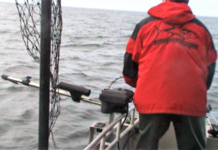
“Marine snow” falls gently on to a coral-covered shipwreck explored in the Gulf of Mexico in 2012 by the NOAA Ship Okeanos Explorer.
Much of the deep sea appears to be fed by the “compost” from the upper sunlit portions of the sea. As plants and animals at the surface die and decay, they fall toward the sea floor, just like leaves and decaying material fall onto a forest floor.
We call this decaying material “marine snow,” because it looks a little bit like white fluffy bits.
In her 1951 book, The Sea Around Us, famous ecologist Rachel Carson wrote that the dust and other material from the top of the ocean might fall to the depths “flake upon flake, layer upon layer — a drift that has continued for hundreds of millions of years . . . the material of the most stupendous ‘snowfalls’ the Earth has ever seen.” When Japanese scientists first described seeing the fluffy stuff from a submarine shortly after World War II, they said it must be Carson’s “snow,” and the name stuck.
Over the past 20 years or so, scientists have measured the amount of useable material in marine snow and found that there is plenty of carbon and nitrogen to feed many of the scavengers in the deep sea.
Many animals in the dark parts of the ocean filter marine snow from the water or scavenge it from the seabed. In areas of high currents, this marine snow will be swept to certain areas of the seafloor until it is deposited.
Fallen structures on the seafloor, such as shipwrecks, are likely begin to be covered by marine snow within a few years. Depending on the site, it may take anywhere from hundreds of years to tens of hundreds of years for a structure to be completely obscured.
For More Information:
Ask an Explorer, Davidson Seamount: Exploring Ancient Coral Gardens
Primary Ocean Production (pdf, 564 kb)
Sign up for the Ocean Explorer E-mail Update List.














